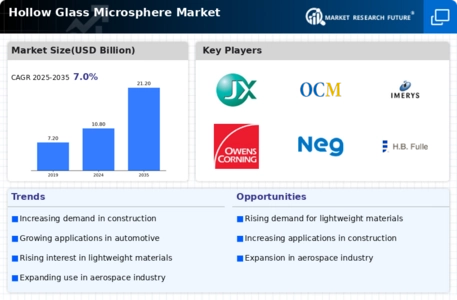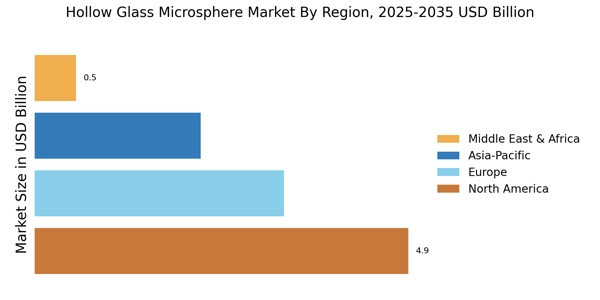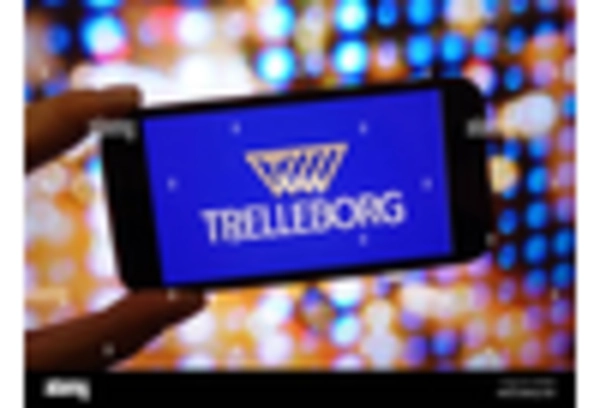Sustainability Initiatives
The increasing emphasis on sustainability is a pivotal driver for the Hollow Glass Microsphere Market. As industries strive to reduce their carbon footprint, hollow glass microspheres offer a lightweight alternative to traditional materials, thereby enhancing energy efficiency. These microspheres are utilized in various applications, including construction and automotive sectors, where they contribute to lower emissions and improved fuel efficiency. The market for hollow glass microspheres is projected to grow at a compound annual growth rate of approximately 6% over the next few years, driven by the rising demand for eco-friendly materials. Furthermore, regulatory frameworks promoting sustainable practices are likely to bolster the adoption of hollow glass microspheres, making them a preferred choice for manufacturers aiming to meet environmental standards.
Technological Advancements
Technological advancements play a crucial role in shaping the Hollow Glass Microsphere Market. Innovations in manufacturing processes have led to the production of microspheres with enhanced properties, such as improved thermal insulation and mechanical strength. These advancements enable the use of hollow glass microspheres in high-performance applications, including aerospace and medical devices. The market is witnessing a surge in research and development activities aimed at optimizing the production techniques, which could potentially lower costs and improve product quality. As a result, the hollow glass microsphere market is expected to expand, with an estimated market size reaching USD 1.5 billion by 2026. This growth is indicative of the increasing reliance on advanced materials in various sectors.
Growing Demand in Diverse Industries
The growing demand for hollow glass microspheres across diverse industries is a significant driver for the Hollow Glass Microsphere Market. Applications in sectors such as construction, automotive, and oil and gas are expanding, as these microspheres provide benefits like weight reduction and enhanced performance. For instance, in the construction industry, hollow glass microspheres are used in lightweight concrete and insulation materials, contributing to energy efficiency. The automotive sector is also increasingly adopting these microspheres to improve fuel efficiency and reduce vehicle weight. Market analysts project that the demand for hollow glass microspheres will continue to rise, with an anticipated increase in market share of around 8% annually, reflecting the versatility and effectiveness of these materials.
Regulatory Support for Lightweight Materials
Regulatory support for lightweight materials is emerging as a key driver in the Hollow Glass Microsphere Market. Governments and regulatory bodies are increasingly advocating for the use of lightweight materials to enhance energy efficiency and reduce emissions in various applications. This support is particularly evident in the automotive and aerospace sectors, where regulations mandate the reduction of vehicle weight to improve fuel economy. Hollow glass microspheres, being lightweight and effective, are well-positioned to meet these regulatory requirements. As a result, manufacturers are likely to increase their adoption of hollow glass microspheres, leading to a projected market growth of approximately 7% over the next five years. This trend indicates a favorable environment for the hollow glass microsphere market.
Rising Investment in Research and Development
Rising investment in research and development is a notable driver for the Hollow Glass Microsphere Market. Companies are increasingly allocating resources to innovate and enhance the properties of hollow glass microspheres, aiming to expand their applications. This investment is crucial for developing new formulations that can withstand extreme conditions, making them suitable for specialized industries such as aerospace and defense. Furthermore, collaborations between academic institutions and industry players are fostering advancements in material science, which could lead to breakthroughs in the performance of hollow glass microspheres. Analysts predict that this trend will contribute to a robust market growth trajectory, with an expected increase in market value of around 5% annually, reflecting the ongoing commitment to innovation in this sector.


















Leave a Comment